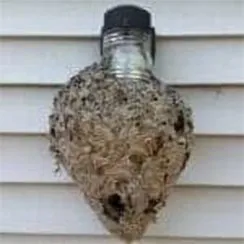NJ Bee, Hornet Control and Exterminator
CARPENTER BEES
Carpenter bees are about 1” in size with shiny mostly black bodies and a small yellow band around their upper body (thorax) by the head. Carpenter bees are often confused for bumble bees, however, lack the large bands of yellow hair around their abdomen. Carpenter bees drill a perfectly round 1/2” entrance hole into wood where they excavate galleries for nesting. They primarily prefer unpainted softwoods for nesting. Nesting sites include house siding, eaves, fascia boards, fences, decks and outdoor furniture. Signs of infestations include heavy carpenter bee activity in a particular area, the accumulation of sawdust in heavily active areas and the presence of yellow to brown excrement stains on surfaces underneath their entrance holes. Male carpenter bees hover and get aggressive when protecting their nesting site, but are harmless because they do not have a stinger. Although the female carpenter bee has a stinger, they rarely sting unless it is handled or molested. Carpenter bees emerge in the spring to reproduce, build a nest and lay eggs before the adults die off.
BOLD-FACED HORNETS

Bold-faced hornets are social, stinging insects related to yellowjackets and get their name from the large patch of white on their face and black body with white markings on their posterior tip. Adults vary in size ranging from 1/2” to 3/4” long. Bald-faced hornets create carton nests that are at least 3’ off the ground usually in trees, bushes, on utility poles, homes and buildings. They are very aggressive and are capable of stinging multiple times.
EUROPEAN PAPER WASPS
European paper wasps are about 3/4” long and black and yellow in color which gets them commonly mistaken for yellowjackets. Despite their resemblance, the European paper wasp has a slender body, narrow waist and can be recognized by their dangling legs in flight. They prefer dark cavities for its nests and will build on a vertical surface as long as it is protected by an overhang such as soffits, under decks, handrails, inside vent louvers, fence posts, BBQ grills, utility boxes, etc. European paper wasps tend to favor flowers to feed on nectar but will also scavenge for dead insects. In addition to being able to sting multiple times, European paper wasps release a chemical odor while in the act of stinging that alarms other wasps in the immediate area to attack as well.
EASTERN YELLOWJACKETS
Eastern yellow jackets are a social, stinging insects that live in nests constructed of layers of combs made of wood fibers chewed into a paper-like pulp. Preferred nesting sites include soil cavities, attics, eaves, porches, or sheds. Workers are about 1/2” long with distinct alternating black and yellow bands on their abdomen. They may initially appear to be bees, but lack the hairy appearance of bees and also do not forage to flowers for nectar like bees. Eastern yellowjackets typically scavenge for sweets and protein-rich foods in and around garbage cans and picnic areas, especially in the fall when populations peak. They have small barbs at the end of their stinger which enables them to deliver multiple stings.











